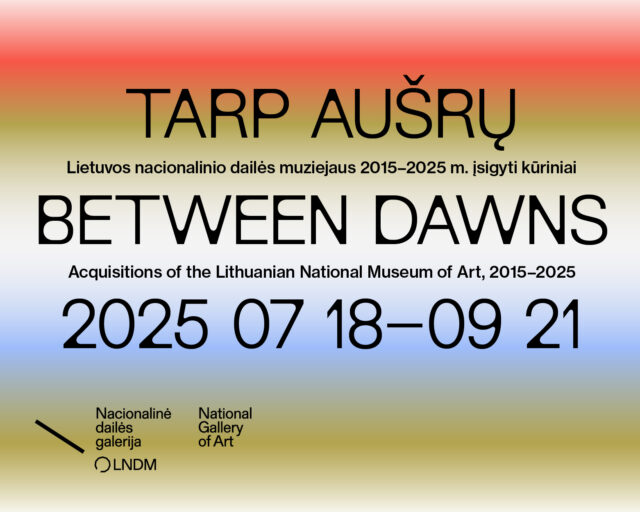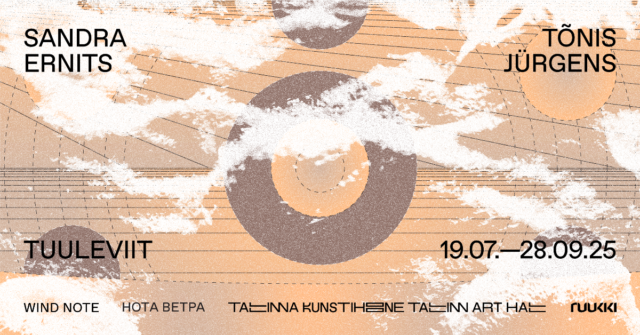Before attending the exhibition “90s” – a project by Virginija Januškevičiūtė with The Baltic Notebooks of Anthony Blunt – I prepared like going to some unknown place on other the side of the continent. Cleared my mind of some expectations, because the title itself has a trendy name and as there is not enough timing from this decade (but when exactly it comes?), associations that attract memories are inescapable. When guidance for preparatory actions are found [1] and acquired, comes moment of revelation, your mind is confronted with large black-and-white shots reminding views from a train window moving from one empty landscape to another. It is interrupted by some men in a process and then journey continues until the drop-off point in a colorful room with hidden surprises. But as I have learned – never trust the first impressions, let them settle. And then again start from a starting-point.
Opinion about the exhibition depends from the beginning on how it is observed. There are two main scenarios: before and after reading Arūnas Svediolas’s essay “The Sieve, the Fog and the Honeycomb: Features of Contemporary Lithuanian Cultural Time and Space”. But the question remains open: can the exhibition be understood without the essay and does it have to be like that? The one way to perceive the works is to view them as signposts referring to the ideas and problems discussed in the essay and thereby opening wider view on the decade “faded and forgotten as they may be, ‘the long nineties’ remain unsubverted.[2] The very chronology of the works reflect the fact that we deal with wider time space. Only one of them stays in this defined time period.
As there are four working titles I suggest to look at them as four steps in climbing the mountain of the decade with Svediolas’s essay in your pocket. In travel books or general history book all the events that have changed the course of the world are placed in chronological order and for understanding the whole it’s important to keep on this track. Without the causes there wouldn’t be the consequences. At this point one should remember (in this case – a Latvian observer) that while ascending the slope you will be faced not only with Lithuanian cultural space but also that of Latvian.
Chronologically the oldest work on display is a photo documentation of Concrete sculptures’ workshop in the territory of a construction elements factory in Vilnius, in 1985-1986, organised by Mindaugas Navakas. There are two documentations by photographers Raimondas Urbakavičius (taken on 1985-86) and Gintautas Trimakas (taken on 2012). In the context of the theme these works don’t stand so much as independent aesthetic values, but rather as signs for personal ambitions for bigger experiments using official resources, in this case concrete for sculpture. And it’s possible to see similarities with our Supergraphics artists (Ojārs Pētersons, Juris Putrāms, Andris Breže, Kristaps Ģelzis, Indulis Gailāns, Normunds Lācis and Vilis Putrāms) whose first politically engaged screen prints were sponsored by Moscow orders, which provided young artists with facilities and materials. [3] In now days this unofficial sculpture park stays as a monument for time and place which was already blown through by winds of changes and uncertain hopes and jet from view of year 2012 full of unfulfilled expectations.
Transformation of the spirit of the age continues in the footages of unfinished project Villa Jogaila by architect Valdas Ozarinskas. From the observers point of view display of these photo documentations (display designed by Valdas Ozarinskas) are intended to be as a nonstop story of shots which continue to shows never ending changes, only in this case after the fall of the Iron Curtain when everything is possible and allowed “a local version of “American dream” and a promise of collective wealth” .[4] But like for every dream there is an awaking part. And as for that it stays as „unfinished construction that still looms as a monument for a collapsed Utopia” .[5] It reflects huge issue that hasn’t ceased yet- what to take, how to make and what to think about that in time when there is no historical background for development of Western European history of ideas in post-Soviet time. But that makes this space more significant, different form of postmodernism. And that leads to the last two works which are not only like time witnesses (probably after a decade they’ll be) but also contemporary comments.
Film The Copy (2010) by Darius Mikšys diverts from the road of history contemplating with a rich commentary. As the explanatory text says making this performance (original dance&music project Madame Plaza by Bouchra Ouizguen) artist attempted to understand another artist’s work by means of doing it. And the first question was – did he succeed? Because all that was seen wasn’t “the complex mixture of longing, regrets, hopes and frustrations played out on stage that’s speaks to an understanding of friendship and female solidarity which will be immediately recognizable to everyone” .[6] It could be easily interpreted as an easy joke replacing these women with four men (Darius Mikšys, Gintaras Makarevičius, Benas Šarka and Rytis Saladžius) to get to know roots of Aitas – traditional Moroccan wedding dancers. But on the other hand it could be an ironical postmodern joke to post modernity using all its weapons. In this case the main is called – “Reverse engineering”, but maybe it is used deliberately to highlight one of the 80’s and 90’s postmodern method – appropriation art? It also could he combined with the tendency in the post-Soviet period to grab and interpret everything new – taking the form without the content. And somehow a little detail in the video – foam plastic peace associatively closed to Soviet period art media division between Baltic States: Latvia – painting, Estonia – graphics and Lithuania – sculpture, and in this case it fits in concrete context. But maybe in the end it is “insights and standards that cancel out each other, tear apart any logic and lead to the most absurd situations – let their productions bounce in the least expected directions” .[7] As the previous work in a way of understanding the concept of the project, it raises more questions than gives answers compared with the first two which can be seen as a complete whole.
The last one – a project by Aurelija Maknytė which was made on the basis of Eliksyras video rental store (working from 1994-2012) is still working in the exhibition’s space offering to use VHS format again with some surprises. It sufficiently concludes the journey of personal sense how the 90s problematic time and space looks like and where it stops and is transformed to new qualities. As a form its visual image – colorful backs of cassette cases brings to a land of opportunity where these films (legal and illegal) are like ideas that you could just take and use and if it’s not working put it back and grab another. But in this specific rental place there are hidden minutes that are recorded by the artist. And this occasion could refer to Aesop’s language disappearance after the collapse of the Iron Curtain when all the colorful ideas came in place. But this time also ended as the video rental shop. And as for now a new decade has started, but question remains open: do we have to start from the beginning or continue on the previous base? As for the exhibition’s view, it concludes the fixed time after 10 years of its actual ending, that what comes in place is already post90s.
[1] The Baltic Notebooks of Anthony Blunt. <http://www.blunt.cc/559919/notebooks/2/arunas-sverdiolas.-kares-migla-un-siets-lietuviesu-laikmetigas-kulturas-telplaika-ipatnibas>. Accessed April 2012.
[2] Frieze Magazine. <http://www.frieze.com/issue/article/the-long-nineties>. Accessed April 2012.
[3] Austriņš, Raivis. 2008. Supergrafiķi. Rīga: Neputns, 96p., il.
[4] Malašauskas, Raimundas. 2002. NU: magazine.
[5] ibid.
[6] Deutsche Welle. <http://www.dw.de/dw/article/0,,5791213,00.html>. Accessed April 2012
[7] Studija. <http://issuu.com/neputns/docs/78-viss>. Accessed April 2012.








Photographs by Valdis Jansons






























